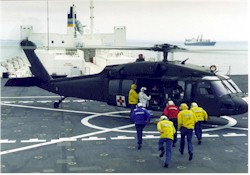|
Aeromedical Briefs
|
Aeromedical briefs from the Naval
Aerospace Medical Institute.
VISION AND VISUAL ILLUSIONS IN FLIGHT (01/2001 Scott A. Shappell, PhD.
{Naval Safety Center})
PPT 97/2000, 14 slides, 446 Kb.
INTRODUCTION TO LASER SAFETY 2001 (04/2001 - SME - LT Tyson
Brunstetter: (NAMRL)
Latest safety procedures dealing with all types of laser encounter
situations.
OPNAV 3750.6Q (01/2001 CAPT James R. Fraser, MC, USN {Naval Safety
Center})
New Naval Aviation Safety Program powerpoint presentation
HUMAN FACTORS COUNCIL (01/2001 CAPT James Fraser, MC, USN {Naval
Safety Center}
New Human Factors Council and Boards in Naval Aviation powerpoint
presentation
CONTROLLED FLIGHT INTO GROUND (CFIT) (LT Eckles-1997)
Presentation includes definition, history, risk factors and reduction
of risks. (MS PowerPoint 4.0, 16 slides with notes) Controlled Flight
into Ground
VESTIBULAR INFORMATION (01/2001 Scott A. Shappell, PhD {Naval Safety
Center}
Alcohol and it's affect to Naval Aviation // Motion Sickness
G
TOLERANCE IMPROVEMENT (CDR Scott Shapely, 01/2001)
Presentations includes effects of negative and postive Gz forces,
G-time/tolerance curve, elements of anti-G protection and AGSM as well
as exercises to improve one's + Gz tolerance. (MS PwrPT 4.0, 48 slides
with notes) G Tolerance Improvement Program
THE HUMAN FACTOR IN NAVAL AVIATION SAFETY (11/97 - CDR A. Bellenkes)
Describes the nature and types of human factors problems encountered
in Naval aviation. Addresses aeromedical, physiological, performance,
and system design issues. Special discussions on
compartmentalization, human error, and Human Factors Councils/Boards
are provided. The key elements for establishing a Human Factors
Safety program are described. (MS Power Point 4.0, 39 slides with
notes). The Human Factor in Naval Aviation Safety
BEYOND ACLS: SHIPBOARD MANAGEMENT OF ACUTE MI (04/97 - CDR G.R. Cox)
Presentation on risk factors of shipboard management of acute
myocardial infarction including diagnosis, initial management
including thrombolytic therapy and aeromedical evacuation. (MS
PowerPoint 4.0, 36 slides) Beyond ACLS: Shipboard Management of Acute
MI
HUMAN FACTORS ANALYSIS AND CLASSIFICATION SYSTEM (FACS) (1/98 - LCDR
Shappell)
Human Factors approach to mishap investigation. Failure Analysis and
Classification System (FACS). FACS addresses the multiple view points
of safety professionals and explains the multiple causes of human
factor accidents, targets the need for specific intervention
strategies. (MS PwrPt 4.0, 27 slides)
HUMAN FACTORS COUNCILS & BOARDS: 12/96 - LCDR Shappell)
Presentation on AIRLANT/AIRPAC Instructions regarding Human Factors
Councils & Humans Factors Boards. The brief steps you through the
specifics of the instruciton and addresses many of the human factors
that adversely affect aircrews. (MS PowerPoint 4.0, 29 slides with
notes, 1.3 MB) Human Factors Councils & Boards
OPERATIONAL CONTACT LENS: (9/97 - LCDR Engie)
Principles of contact lenses, Navy and USMc contact lens policy and
management considerations. (MS Power Point slides, 10 MB) Operational
Contact Lens
|
AEROMEDICAL ASPECTS OF EJECTION, SJU-5/6 EJECTION SEATS (2/97 - LCDR
Hathaway)
Body position, hand position, decision to eject, ejection
sequencing, parachuting techniques, injury patterns are all addressed.
(MS PowerPoint 4.0, 19 slides) Aeromedical Aspects of SJU-5/6 Ejection
Seats
AEROMEDICAL ASPECTS OF EJECTION, NACES EJECTION SEAT (2/97 - LCDR
Hathaway)
Body position, hand position, decision to eject, ejection
sequencing, parachuting techniques, injury patterns are all addressed.
(MS PowerPoint 4.0 20 slides) Aeromedical Aspects of NACES Ejection
Seat
OPERATIONAL RISK MANAGEMENT (ORM) INDOCTRINATION: (8/97 - SAFECEN)
Introduction to the terms, concepts and process of ORM. Focus on
"Time Critical" process. (MS PwrPt 4.0, 23 slides with
notes). Operational Risk Management Indoctrination
SLEEP, NAPPING, AND CIRCADIAN DYSRHYTHMIA: (12/96-LCDR Scott A.
Shappell)
Everything you need to know about such issues as circadian
rhythms, jet lag, sleep and napping. It answers the questions of how
much sleep you need, when you need to get it, and how to ward off the
sleep monster when you don't (MS PowerPoint 4.0, 19 slides. Sleep,
Napping, and Circadian Dysrhythmia
SELF-PACED AIRSICKNESS DESENTIZATION (SPAD): (3/98 - LT D. Bunting and
CDR H. Porter)
A comprehensive treatment of last resort for airsickness in
aircrew who have not adapted to the disequilibrating environment of
flight. SPAD use of cross-coupled coriolis stimulation combined with
extensive biofeedback techniques have enabled most aircrew with
seemingly intractable airsickness to return to flying. SPAD MS
PowerPoint97, 19 slides, 3MB
SPAD MS PowerPoint 4.0, 19 slides, 14 MB
STRESS AND HUMAN PERFORMANCE (02/97 - LT Yniguez)
Definitions, NATOPS, Physiology, Caffeine, Alcohol, Dehydration,
Heat/Cold, Rest, Exercise & Nutrition, Crew Coordination are crew
topics addressed. (MS Power Point 4.0, 28 slides with notes: .42MB)
Stress and Human Performance
TAXONOMY OF UNSAFE OPERATIONS: 12/96 - LCDRs Shappell & Wiegmann)
Human Factors approach to mishap investigation. (MS Power Point
4.0, 26 slides with notes) Taxonomy of Unsafet Operations
VESTIBULAR FOLLIES: (11/97 - LCDR Shappell)
Vestibular apparatus, components of vestibular system, and the
vestibular effects of alcohol are discussed. (MS PowerPoint 95, 20
slides with notes) Vestibular Follies
VISION AND VISUAL ISSULATIONS IN FLIGHT (8/98-LCDR Shappell)
A review and explanation of aviation vision issues. Anatom,
physiology, illusions and spatial disorientation are presented. (MS
PowerPoint 95, 14 slides with notes) Visual Illusions
WOMEN IN NAVAL
AVIATION (1996 - A. Baisden)
Chronology of women in naval aviation, selection and performance
measures, and Presidential Commission finding are presented. (MS
PowerPoint 4.0, 20 slides) Women in Naval Aviation
|
Naval Aerospace Medical Institute
340 Huise Road
Pensacola FL 32508-1092
Home
·
Textbooks and Manuals
·
Videos
·
Lectures
·
Distance Learning
·
Training
·
Operational Safety
·
Search
This website is dedicated to the development and dissemination of medical information that may be useful to those who practice Operational Medicine. This website is privately-held and not connected to any governmental agency. The views expressed here are those of the authors, and unless otherwise noted, do not necessarily reflect the views of
the Brookside Associates, Ltd., any governmental or private organizations. All writings, discussions, and publications on this website are unclassified.
© 2006 Medical Education Division, Brookside Associates, Ltd. All rights reserved
Other Brookside Products
Contact Us

|
|
